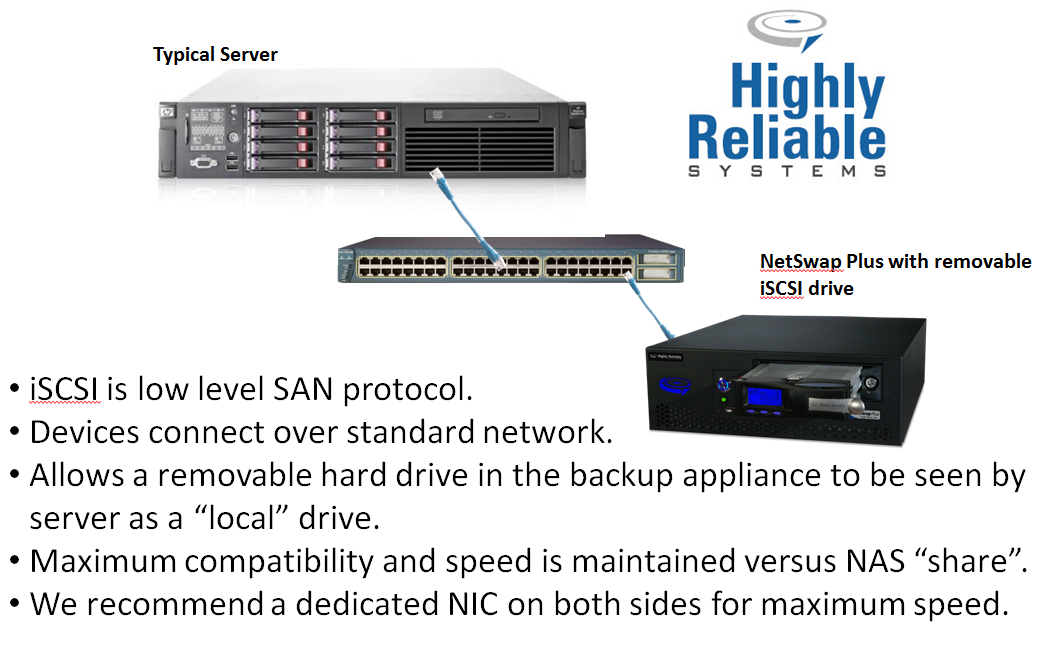 Perhaps one of the more confusing terms in networking is iSCSI (pronounced eye-SKUZ-ee). The acronym iSCSI is for Internet Small Computer System Interface. Most people think of SCSI as a type of hard drive, or a physical interface for a particular type of hard drive. This leads to confusion because iSCSI isn’t a physical interface. iSCSI is a software protocol used for sending hard drive data over IP networks. So to physically connect an iSCSI device, you use an Ethernet cable. When using removable iSCSI for backup, think of iSCSI as an “extension cord” for a hard drive. It allows you to take a hard drive that would normally be physically inside your machine and put it across the network inside another machine. The protocol then allows you to “speak” to the remote hard drive at the block level, as if it were local. In some implementations you can even boot from a remote iSCSI drive!
Perhaps one of the more confusing terms in networking is iSCSI (pronounced eye-SKUZ-ee). The acronym iSCSI is for Internet Small Computer System Interface. Most people think of SCSI as a type of hard drive, or a physical interface for a particular type of hard drive. This leads to confusion because iSCSI isn’t a physical interface. iSCSI is a software protocol used for sending hard drive data over IP networks. So to physically connect an iSCSI device, you use an Ethernet cable. When using removable iSCSI for backup, think of iSCSI as an “extension cord” for a hard drive. It allows you to take a hard drive that would normally be physically inside your machine and put it across the network inside another machine. The protocol then allows you to “speak” to the remote hard drive at the block level, as if it were local. In some implementations you can even boot from a remote iSCSI drive!
The iSCSI hard drive “at a distance” is a little different than connecting to a “share” on a Windows server or NAS (Network Attached Storage). They both allow you to have storage at the end of an Ethernet cable. The difference is the NAS share is (sometimes) slower, because the software protocol involves the upper layers of the operating system, including user/password authentication and permissions on the share. By contrast iSCSI uses low level block transfer protocols, relying upon the connecting machine’s security.
Another key difference between NAS and iSCSI is that typically once you connect to a hard drive across the LAN with iSCSI that hard drive is unavailable to other machines on the network. Sharing that same drive in NAS mode allows multiple machines to connect to the share simultaneously. Confusingly enough, if you connect via iSCSI from one server and then “share” (or reshare if you prefer) the drive, other machines on the network can see it. You can imagine in this scenario each access might require double traffic on the network. One packet from the client would be sent to the “server”. The server then has to send that packet using the iSCSI protocol to a second machine (i.e. the NetSwap Plus) that physically has the drive.
iSCSI is generally considered a SAN protocol (Storage Area Network). So appliances that have this method of file sharing are sometimes referred to a SAN rather than a NAS. The truth is, a SAN has much more functionality for managing and expanding storage than a NAS but the line has become somewhat blurred. If you have an Ethernet connected appliance, you can only tell if it is acting as a NAS (Network Attached Storage) or a SAN using iSCSI by looking at the software. The physical connection is identical.
Highly Reliable Systems is one of the only vendors that provides iSCSI connector software that manages iSCSI for removable drives. The software reconnects upon drive removal and when coupled with our media management software (HRDM2) drives can be automatically “re-shared” at the client side after a drive swap. Since media are removable, each drive in the NAS must be designated as either iSCSI or NAS for the entire drive.
iSCSI connectivity often gets around domain security issues, and in our implementation, is faster than a NAS share. You can format the hard drive as if it were a local Windows drive, providing maximum compatibility and speed.

